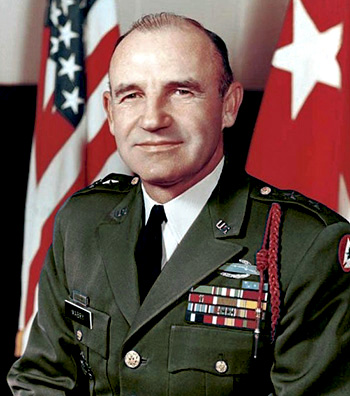
|
George L. Mabry, Jr. |
 |
|||
| Rank, Service | ||||
Major General O-8, U.S. Army |
||||
| Veteran of: | ||||
|
||||
| Tribute: | ||||
George Mabry was born on September 14, 1917, in Sumter, South Carolina. He was commissioned a 2d Lt of Infantry through the Army ROTC program at the Presbyterian College in Clinton, South Carolina, on June 1, 1940. His first assignment was with the 8th Infantry Regiment of the 4th Infantry Division at Fort Benning, Georgia; Camp Gordon, Georgia; Fort Dix, New Jersey; and at Camp Johnson, Florida, from July 1940 to January 1944. He then deployed as the Commanding Officer of the 2nd Battalion of the 8th Infantry Regiment to Europe from January 1944 to July 1945, during which time he would be awarded the Medal of Honor for action near Schevenhutte, Germany, in November 1944. After returning to the United States, LTC Mabry served as Regimental Executive Officer for the 8th Infantry Regiment at Camp Butner, North Carolina, from July 1945 to January 1946, followed by service as a G-3 Staff Officer with Headquarters 1st Army at Fort Bragg, North Carolina, and at Governor's Island, New York, from January to September 1946. He attended the Infantry Officer Advanced Course at Fort Benning from September 1946 to June 1947, and then served on the faculty of The Infantry School from June 1947 to September 1949. After attending Command and General Staff College at Fort Leavenworth, Kansas, he served as a Battalion Commander and Regimental Executive Officer for the 33rd Infantry Regiment at Fort Kobbe in the Panama Canal Zone from July 1950 to June 1952. His next assignment was as Operations and Training Staff Officer, and then as Assistant G-3, with U.S. Army Caribbean at Fort Amador in the Panama Canal Zone from June 1952 to July 1953, followed by Armed Forces Staff College at Norfolk, Virginia, from August 1953 to January 1954. Col Mabry served as G-3 Staff Officer with Headquarters Army Field Forces at Fort Monroe, Virginia, from January 1954 to January 1956, and then as Commander of the 31st Infantry Regiment of the 7th Infantry Division in South Korea from January to October 1956. He remained in Korea as G-3 for I Corps from October 1956 to January 1957, and then served with Headquarters U.S. Army Training Center, Infantry, at Fort Jackson, South Carolina, from January to June 1957. His next assignment was as Commander of the 3rd Training Regiment at Fort Jackson from June to August 1957, followed by National War College at Fort McNair, Washington, D.C., from August 1957 to June 1958. Col Mabry served as a Staff Officer with the Office of the Deputy Chief of Staff for Operations with Headquarters U.S. Army in the Pentagon from July 1958 to June 1960, and then as a J-3 Staff Officer on the Joint Staff in the Pentagon from July 1960 to April 1962. After attending the U.S. Army Special Warfare School at Fort Bragg, Gen Mabry served as Chief of the Collateral Activities Branch and as Acting Chief of Staff with Headquarters U.S. Caribbean Command at Quarry Heights in the Panama Canal Zone from June 1962 to July 1963, followed by service as Director of J-3 with Headquarters U.S. Southern Command at Quarry Heights from July 1963 to July 1965. His next assignment was as Commander of the 1st Armored Division at Fort Hood, Texas, from August to December 1965, and then as Chief of the U.S. Army Evaluation Team in South Vietnam from January to April 1966. He again commanded the 1st Armored Division at Fort Hood from May to July 1966, and then served as Commanding General of U.S. Army Combat Developments Command Experimentation Command at Fort Ord, California, from July 1966 to January 1968. His next assignment was as Commanding General of the 8th Infantry Division at Bad Kreuznach, West Germany, from January 1968 to April 1969, followed by service as Chief of Staff for the Assistant Commanding General of U.S. Army Vietnam from April 1969 to September 1970. Gen Mabry served as Commander of U.S. Army Forces Southern Command at Fort Amador from December 1970 to December 1974, and then at Fort Sheridan, Illinois, from January 1975 until his retirement from the Army on August 1, 1975. George Mabry died on July 13, 1990, and was buried at the Holy Cross Episcopal Church Cemetery in Stateburg, South Carolina. |
||||
|
||||

